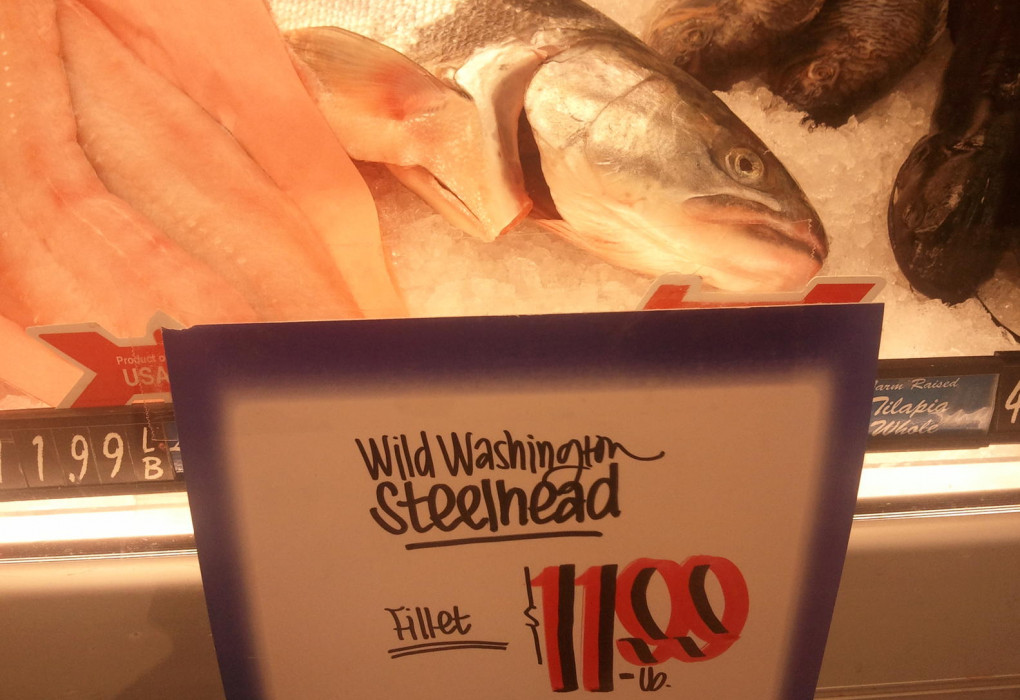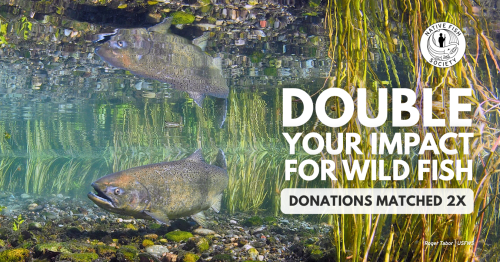What's Not For Dinner | Wild Steelhead
March 23, 2017
Julie Packard
Executive Director
Monterey Bay Aquarium
886 Cannery Row Monterey, CA 93940
Jennifer Dianto Kemmerly
Seafood Watch
886 Cannery Row
Monterey, CA 93940
Re: Olympic Peninsula Wild Steelhead as a “Good Alternative” choice by Seafood Watch
Dear Ms. Packard and Ms. Kemmerly:
The Conservation Angler, Wild Steelhead Coalition, Steelhead Trout Club, Native Fish Society, Washington Flyfishing Club and Wild Fish Conservancy are all deeply disappointed by Seafood Watch’s decision to list tribally harvested wild steelhead from the Quillayute, Hoh, Queets, Quinault and Humptulips as a "Good Alternative" seafood choice. These tribal fisheries are not sustainable and do not come close to meeting Seafood Watch Standards and Criteria for evaluating fisheries.
The Seafood Watch Standards and Criteria claim to adhere to the following principles of ecosystem-based fisheries management:
-The fishery is managed to ensure the integrity of the entire ecosystem, rather than solely focusing on maintenance of single species stock productivity.
-To the extent allowed by the current state of the science, ecological interactions affected by the fishery are understood and protected, and the structure and function of the ecosystem is maintained.
Incredibly, none of the tribal fisheries on the rivers noted above meet this standard. Historically, wild steelhead populations in these river systems entered the rivers in large numbers beginning in mid-November continuing through May. The November-January component of this natural population has been severely depleted to the brink of extirpation. None of the fisheries Seafood Watch certifies are managed to foster recovery of this life history component of the populations (historically comprising 40-%-50% of the total run).
One also cannot only look at the effects the tribal fisheries have had on winter steelhead, but also other races of steelhead and other species of salmon. For instance, the summer run life history in wild steelhead in these rivers has been virtually extirpated as well. Once-abundant sockeye and chum populations on the Quinault and Queets rivers have been decimated by tribal fisheries - historical runs numbering in the millions have been reduced down to a few thousand. In some cases they are extinct. Lastly, the Hoh River spring Chinook are critically depressed, but tribal fisheries continue to intercept significant numbers of spring Chinook in their winter steelhead fishery. None of the fisheries in question contain any provisions to protect ESA-listed bull trout. In each of the Seafood Watch-approved Olympic Peninsula steelhead fisheries, current wild winter steelhead population are trending downward, with current populations representing less than 15%-20% of recent (1960's) abundance. These systems all have low human habitation, and large swaths of their watersheds are pristine and protected in the Olympic National Park (ONP).
In fact, there is probably no better salmon and steelhead habitat remaining in the lower-48 states, and yet the populations continue to decline. The problem is not the habitat. The problem with the fisheries begins with the inadequate escapement goals. For example, Hoh and Queets wild winter steelhead populations are managed for incredibly low escapement goals: 2400/4600 respectively. (Note: the Quinault Nation refuses to accept the Queets escapement goal, saying it is too high.) Current escapement goals are about 15% of wild steelhead runs in those rivers just fifty years ago. Even with the incredibly low escapement goal of 2400, Hoh winter steelhead have met that escapement goal less than half the time! We have examined Seafood Watch’s specific standards and believe that the Quillayute, Hoh, Queets, Quinault and Humptulips tribal fisheries (there are no recreational harvest fisheries for wild winter run steelhead) do not meet any of them:
1. Follow the principles of ecosystem-based fisheries management; NO. These are not even considered in these fisheries.
2. Ensure all affected stocks are healthy and abundant; NO. Targeted winter steelhead and co-mingled other salmonids are all depressed and their populations are trending downward under the fisheries Seafood Watch certifies.
3. Fish all affected stocks at sustainable levels; NO - see above.
4. Minimize bycatch: NO. Early season tribal fisheries targeting hatchery steelhead continue to kill dangerously depressed early-timed wild winter run steelhead. Summer and fall salmon tribal fisheries intercept wild summer steelhead, ESA-listed bull trout, and severely depleted/nearly extirpated chum salmon and sockeye salmon.
5. Have no more than a negligible impact on any threatened, endangered or protected species; NO - see above. The ongoing tribal steelhead and salmon fisheries continue to significantly impact ESA-listed bull trout, depressed spring/summer Chinook, and have largely extirpated Quinault/Queets sockeye and chum salmon.
6. Are managed to sustain long-term productivity of all affected species; NO - see above.
7. Avoid negative impacts on the structure, function or associated biological communities of marine habitats where fishing occurs; UNKNOWN - There is no available data to assess.
8. Maintain the trophic role of all marine life; UNKNOWN - There is no available specific data to assess.
9. Do not result in harmful ecological changes such as reduction of dependent predator populations, trophic cascades, or phase shifts; UNKNOWN - There is no available specific data to assess.
10. Ensure that any enhancement activities and fishing activities on enhanced stocks do not negatively affect the diversity, abundance or genetic integrity of wild stocks; NO. Both tribal entities and the Washington Department of Fish & Wildlife (WDFW) continue to plant hundreds of thousands of hatchery steelhead in the rivers in question, despite unequivocal evidence of the extensive harmful impacts of those practices on wild steelhead populations. The scientific literature clearly indicates that such hatcheries and their associated fisheries are the main cause of the decline in early-timed winter steelhead. Tribal fisheries targeting these early returning hatchery steelhead pose an extreme risk to early returning wild fish, which historically constituted 40%-50% of the total run. Gill nets do not discriminate.
Criterion 3 - Management a. High chance of avoiding declines – NO. As can be seen above, these fisheries have experienced drastic population declines, which are continuing. b. Research and Monitoring – NO. Although many miles of these watersheds are inside the ONP, there is no effective monitoring program to assess spawning levels, egg-smolt survival rates, utilization rate of available habitat and so on. Sadly, Hoh tribal officials have refused to join in a long-term study on the Hoh River conducted by WDFW and ONP and partially funded by conservation organizations, preferring to manage by assumption/guess rather than by rigorous empirical data.
c. Monitoring/enforcement/stakeholder inclusion - NO. Non-tribal fishers are completely excluded from management and harvest decisions. Further, tribal fishers refuse to consider pinniped predation and net drop out (both significant) in their fisheries, which contributes significantly to the continuing decline in wild winter steelhead in all the rivers Seafood Watch certified. It should be noted that non-tribal recreational anglers asked the Washington Fish & Wildlife Commission to close all harvest of wild steelhead, allocating their share of allowable harvest towards increased escapement. Despite this action, some tribes regularly harvest above their 50% allocation and Steelhead Harvest Management Plans are typically not signed by both parties before the Dec. 1 steelhead fishing seasons begin, and sometimes not at all. Even more confusing, Seafood Watch lists Chehalis River steelhead in the “avoid” category which, based on fisheries, management, monitoring and enforcement standards, is indistinguishable from the Quillayute, Hoh, Queets, Quinault and Humptulips.
Certifying tribal driftnet fisheries for wild winter steelhead in the Quinault, Hoh, Queets, Quinault and Humptulips rivers as Seafood Watch's “Good Alternative” is a grave mistake. It is not factually based, ignores declining population trends over the past fifty years (which continue), and drastically undermines any sense that Seafood Watch is applying a credible, scientifically objective and fact-based assessment process.
The undersigned organizations urge your organizations to immediately launch a review of your certification and the underlying analysis. While that is underway, this listing should be downgraded to the “Avoid” category immediately.
Sincerely,
Pete Soverel President, The Conservation Angler
Rich Simms, Wild Steelhead Coalition Board of Directors
Al Senyohl President, Steelhead Trout Club
John Gravendyk President, Washington Fly Fishing Club (WFFC)
Mark Sherwood Executive Director, Native Fish Society
Kurt Beardslee Executive Director, Wild Fish Conservancy


